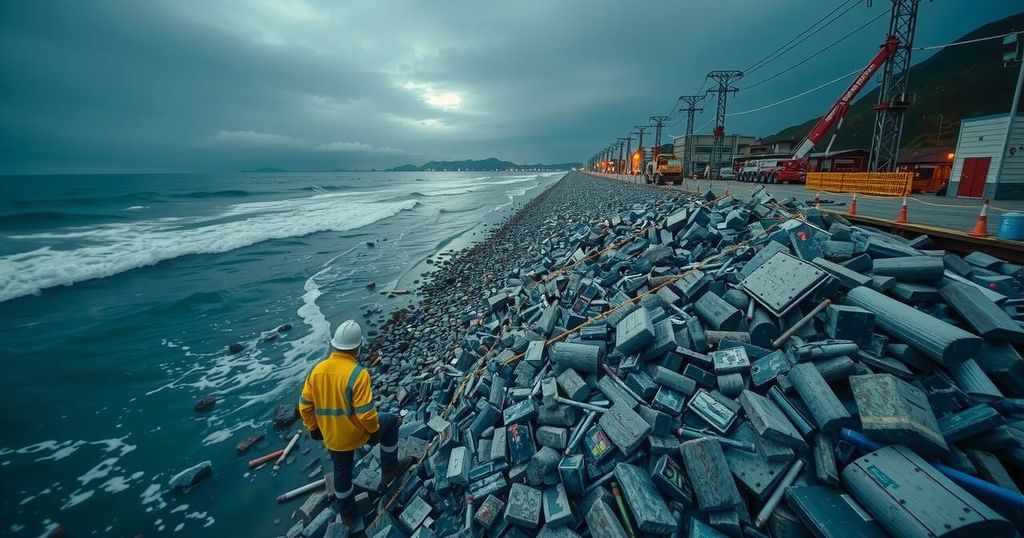Japan Earthquake and Tsunami of 2011: Relief, Rebuilding, and Recovery
The 2011 Japan earthquake and tsunami prompted immediate relief measures led by the Japanese government, supported by international assistance. Initial efforts were hindered by severe destruction and inclement weather, complicating search and rescue missions. Numerous individuals were displaced, facing critical shortages in shelters, while businesses struggled with power supply issues and production disruptions. Significant government budgets were allocated for reconstruction, with ongoing efforts to establish a coordinated recovery strategy. By early 2015, debris was removed, and rebuilding progressed effectively, though challenges remained, especially around the Fukushima nuclear crisis.
In the aftermath of the catastrophic earthquake and tsunami that struck Japan on March 11, 2011, the Japanese government implemented extensive relief and rebuilding measures to address the crisis. Prime Minister Kan Naoto swiftly established an emergency command center in Tokyo and mobilized a substantial number of rescue workers, including approximately 100,000 personnel from the Japanese Self-Defense Force. In addition, the government solicited assistance from U.S. military forces stationed in the region, leading to the deployment of a U.S. Navy aircraft carrier to aid in relief operations. Numerous countries, including Australia, China, India, New Zealand, South Korea, and the United States, dispatched search-and-rescue teams, while international relief organizations, such as Red Cross and Red Crescent, pledged financial and material support to Japan. Concurrently, several non-governmental organizations (NGOs) established relief funds to assist with rescue and recovery efforts. Despite these efforts, initial rescue operations faced significant hurdles due to the devastation of the affected areas and inclement weather, which hindered air operations. The landscape revealed overwhelming destruction, with entire towns and cities obliterated or buried under debris. Although some individuals were rescued from the rubble, many rescue operations focused on recovering the deceased, with hundreds of bodies discovered along the coast. In the immediate aftermath, several hundred thousand individuals sought refuge in temporary shelters, often grappling with inadequate supplies of food and water. A significant number of individuals remained stranded in hard-hit regions, and as the situation at the Fukushima nuclear plant worsened, the number of displaced persons increased. While many eventually found alternative housing in the Tōhoku region or relocated elsewhere in Japan, as of two weeks post-disaster, approximately a quarter of a million residents were still residing in shelters. Two years later, over 300,000 individuals were living in temporary housing units, with substantial numbers continuing to exist in emergency shelters. The infrastructure of northern Honshu gradually recovered, with transportation and services returning to operation. Nonetheless, the ongoing circumstances at the Fukushima plant led to persistent disruptions in the power supply, resulting in power outages and rolling blackouts. The earthquake and tsunami devastated numerous businesses, particularly in high-tech manufacturing and automotive sectors, though recovery efforts led to a revival of industrial output by early 2012. In response to the ongoing challenges, the Japanese government instituted three disaster-related supplemental budgets throughout 2011 and 2012, culminating in a significant budget allocation of approximately $155 billion for reconstruction. Furthermore, the establishment of a cabinet-level Reconstruction Agency aimed to coordinate rebuilding efforts in the Tōhoku area, projected to last ten years. By early 2015, nearly all disaster debris had been cleared, with the agency reporting progress on infrastructural projects, including coastal defenses and higher-ground reconstruction.
The profound impact of the earthquake and tsunami that struck Japan on March 11, 2011, marked a pivotal moment in the nation’s history. Known as the Tōhoku earthquake and tsunami, it resulted in catastrophic loss of life, extensive physical destruction, and an ongoing humanitarian crisis exacerbated by the failure of the Fukushima Daiichi nuclear power plant. The scale of the disaster prompted a massive national and international response aimed at immediate relief and long-term recovery, requiring coordination between governmental agencies, foreign support, and various non-governmental organizations. This event not only tested Japan’s disaster response mechanisms but also highlighted the need for comprehensive rebuilding strategies and infrastructural resilience in the face of future calamities.
In summary, the response to the 2011 Japan earthquake and tsunami was characterized by swift government action and unprecedented international aid efforts. Overcoming initial challenges, the relief initiatives gradually transitioned into extensive recovery and rebuilding programs, which involved significant governmental funding and the establishment of specialized agencies to coordinate the efforts. Although substantial progress was achieved in terms of infrastructure restoration and the reduction of displaced populations, the long-term consequences of the disaster continue to necessitate vigilant oversight and strategic planning to fully address the ongoing needs of affected communities.
Original Source: www.britannica.com




Post Comment